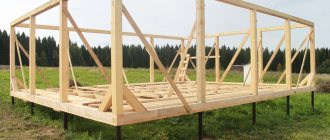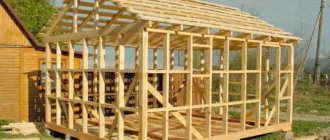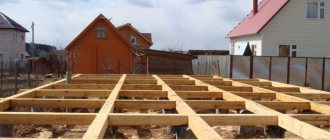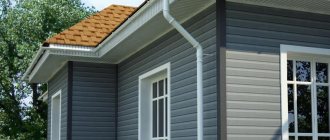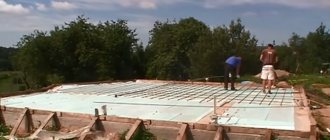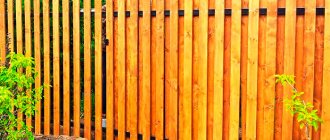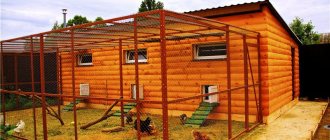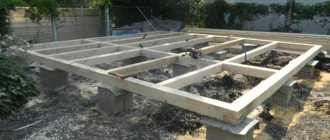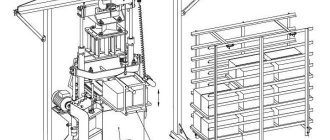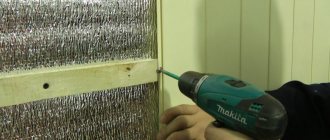Design features of frames
From the name of a frame garage, it is easy to guess what lies at the heart of its design.
A frame garage is a structure constructed entirely of wood. There are only metal fasteners and connecting elements (perforated corners and plates) . The name of the technology is “speaking”, informing that the basis of the structure is the frame. After covering it with the selected material, a full-fledged building with load-bearing and non-load-bearing walls, a rafter system and floors is obtained.
There are three technologies for constructing buildings of this type:
- Canadian. A distinctive feature is the use of SIP panels. These products consist of thick (10-20 cm) polyurethane foam, covered on both sides with OSB (oriented strand board) sheets 9-12 mm thick.
- Frame-panel, which involves the assembly of large panels from boards and their subsequent installation in the frame openings.
- Frame-frame. The easiest to implement, allowing you to perform the entire range of work with your own hands, without the involvement of assistants and lifting equipment. This particular method of building a garage will be discussed next.
Basic elements of a frame structure
Wooden frame garage - inside view
The frame building consists of the following elements:
- foundation;
- bottom trim;
- wall frame made of vertical row and corner posts;
- sheathing;
- top floor;
- rafter system (absent in buildings with flat roofs);
- roofs.
The lumber used in construction is timber with a section of 100x100 or 150x150 mm and boards with a section of 15x50 mm and 25x20 mm. Sheathing - OSB boards 9 mm thick.
On a note! Lumber does not always have the correct geometric parameters. Often boards and beams are curved to one degree or another. It is recommended to use a surface planer to calibrate materials. Since the tool is quite expensive, you can rent it and complete all the work on leveling the lumber in 1-2 days.
Do you need timber?
When building a frame wooden garage, timber is not indispensable
The technology allows you to replace the timber with a package of boards laid on edge and connected to each other with nails and metal pins with a cross-section of 6-8 mm . The price of solid timber and prefabricated timber is approximately the same. But the second one has one undeniable advantage: the prefabricated beam practically does not lead.
Otherwise, it is inferior to timber. When designing, it is taken into account that the permissible loads for it are 15% less than for solid lumber. But a garage is a lightweight structure that does not require significant pressure on the foundation and floors. Therefore, in order to save money and make it easier to carry lumber with your own hands, you can safely use beams from a package of boards.
Finishing
The interior decoration of the utility room is often completely absent. Especially if the garage is built without insulation. Less often, when arranging a warm garage, it becomes necessary to close the insulating material from the interior space. In this case, interior decoration becomes necessary and mandatory.
There are no moisture resistance requirements for the material of the internal wall cladding. Therefore, panels made from wood waste (OSB, chipboard) or plywood sheets are often used. If necessary, make shelves and cabinets built into the wall, attaching them to the supports of the garage frame.
Insulation
The need for insulation arises when it is necessary to carry out any work in the garage in winter. Or when you plan to set up a warm garage with the ability to dry the bottom of the car after driving in the cold and wet season.
Do-it-yourself insulation.
Insulating a garage differs from similar work in residential buildings in the choice of heat insulator. If it is important to ensure a healthy microclimate in residential premises and arrange natural air circulation, then insulation in a garage is easier. You can get by with a forced periodically operating hood. And also use less useful and cheaper insulation materials - polystyrene foam and glass wool.
When insulating with glass wool, it is placed between the vertical posts. Thanks to its compressibility, it is easily held in space. The thickness of the cotton insulation is determined by the level of winter temperatures. For residential buildings at an average temperature of -10°C, choose a thickness of cotton wool insulation of up to 100 mm. For garages and other utility rooms, choose a thickness of up to 50 mm.
On a note
When insulating with glass wool, it is important to take into account that the material may sag over time. In places where the glass wool sag, “cold bridges” will form, through which heat will “leak away.”
Foam insulation does not have the disadvantages of using glass wool. The foam does not settle over time and does not lose its shape. At the same time, it is quite inexpensive, which makes it a popular material for frame garage insulation.
If residential premises are not recommended to be insulated with polystyrene foam due to possible harmful fumes, then this type of insulation is optimal for a garage space. It is inexpensive, easy to install and works for a long time as a heat insulator, retaining heat inside the building.
When installing foam plastic, gaps form between the frame posts. This is due to the rigidity of foam boards. The resulting mounting gaps are filled with foam.
Types of garage doors
The frame garages in the photo differ in the design of the entrance gate. Traditionally, garage doors are made with double-leaf doors. However, other designs are also possible. What types of garage doors can there be?
Gates.
Swing gates are a traditional form of gate in the form of doors that swing open to the outside of the room. The simplest and most accessible design to build with your own hands. Opens manually.
Sliding is an improved form of garage entry, which can be supplemented with an automatic device. In this version, the garage door slides to the side along rails when a signal is given from a remote device.
Lifting and roller shutter structures are also possible, but their cost is much higher, so they are less often used in frame structures.
Pros and cons of a frame garage
The number of advantages of a frame wooden garage is several times greater than the disadvantages
Like any other building construction technology, frame technology has its advantages and disadvantages. Moreover, there are much more of the former than all other methods of constructing a garage.
Pros:
- High speed of construction. If there are good weather conditions, a frame measuring 4x6 m can be built with your own hands in 3-4 weeks.
- Durability. A garage built according to all the rules will last at least 50 years.
- Internal and external walls do not require additional finishing in the form of plastering and leveling, as they are flat and smooth surfaces.
- Possibility of constructing a lightweight, inexpensive foundation.
- Minimal shrinkage or its complete absence, provided that high-quality dried lumber is used.
- Ecological cleanliness.
- Lower thermal conductivity than brick and concrete buildings.
- Ability to withstand significant and frequent temperature changes.
- All-season construction.
- Indoor microclimate favorable for human health.
Minuses:
Among the disadvantages of frame technology, the hygroscopic nature of wood, its susceptibility to rotting and damage by wood-boring insects are primarily noted. Risks are minimized by treating lumber with special solutions - antiseptics. One of the most popular is “Senezh”. It is recommended to apply 2-3 layers of solution.
The second disadvantage of frames is the fire hazard. In order to increase the resistance of wood to high temperatures, special fire-bioprotective products have been developed. That is, they are also antiseptics, which allows you to save on the purchase of these solutions. The most popular and effective:
- "Senezh Ognebio";
- "Senezh Ognebio Prof";
- NEOMID from Neohim;
- "Pirilax" from "NPO NORTH";
- "Woodmaster" from "NPP Rogneda".
Among the disadvantages of frame-type buildings is the difficulty of attaching hanging elements (shelves, cabinets, mirrors, etc.) to the walls. In order for a nail or self-tapping screw to reliably withstand the load, it must be driven into a beam or board.
Frames have a significant surface area - cavities filled with insulation (mineral wool or polystyrene foam/polyurethane foam). Therefore, when designing a structure, it is necessary to provide in advance for the presence of beams in those places where hanging interior elements will be installed.
Video: how to build a garage yourself in just 132 hours
A frame garage is not only one of the cheapest methods of construction, but also the fastest. You will be able to install it yourself, and when you have gatherings with friends, tell them that you did everything from the foundation to the roof yourself. It's truly a worthwhile investment.
- Author: Olga Morozova
Hello. My name is Olga. I am 27 years old. A journalist by training. Rate this article:
- 5
- 4
- 3
- 2
- 1
(33 votes, average: 4.3 out of 5)
Share with your friends!
Drawing up a project and cost estimate
Wood frame garage project
Before starting to design a frame garage, they study the features of the materials used in its construction. The length of standard boards and timber is 6 m. You can order products of other sizes, but you will have to pay extra for this.
On a note! By choosing building dimensions corresponding to 3 and 6 meters, they simplify the construction process, reduce its time and minimize the amount of waste.
In order to maximize cost savings, the geometric parameters of facing and roofing materials are also taken into account when designing.
For a 3x6 garage with a wall height of 3 m you will need:
- timber 150x150 mm – 1.6 m3;
- boards 50x150 mm – 2.1 m3;
- boards 25x150 mm – 1.9 m3;
- boards 50x100 mm - 0.7 m3 (for the floor, if it is wooden).
The advantage of frame construction is that you can save on lumber for formwork. It is constructed from what is available, but to protect it, the shields are covered with thick plastic film. After dismantling the formwork, the boards are used for their intended purpose: to erect a frame.
Mandatory budget items
| Purpose | Materials |
| Foundation made of monolithic reinforced concrete slab | — hydroglass insulation or roofing felt for waterproofing; - sand for filling the “pillow” with a thickness of 20-30 cm; — concrete M-300; - metal rods for reinforcement. |
| Frame of walls and ceilings, rafter system | — timber 150x150 mm; — boards 50x150 mm; - boards 50x100 mm. |
| Cladding of internal and external walls | OSB-3 (thickness 9 mm) |
| Roof sheathing | Boards 25x150 mm |
| Roof cladding | Ondulin, corrugated sheets, flat or wave-shaped slate, flexible tiles, metal tiles. Board 25x150 mm for filing eaves overhangs. |
| Insulation of walls and ceilings | Basalt slabs Rockwool “Light Butts” 150 mm thick. |
| Fire protection of wood | "Senezh Ognebio" |
| Fasteners | Metal corners, wood screws, nails. |
On average, the cost of materials for the construction of a 4x6 m garage with a wall height of 2.7 m is 278 thousand rubles. (data current as of early 2021) . The work of specialists in the construction of a building costs 180-200 thousand rubles.
To find out the exact amount of materials needed for the construction of a frame garage, you can use an online calculator that performs calculations in accordance with SP 31-105-2002.
To do this, you need to specify the structure parameters:
- length;
- width;
- height;
- step between floor beams (recommended 400 mm);
- pitch between row frame posts (recommended 600 mm);
- insulation thickness (100-200 mm).
Advice! It is advisable to assemble the frame with nails, as they effectively prevent the materials from moving in any direction. Self-tapping screws work better when pulled off.
Gable garage
It is more difficult to install such a roof, but by choosing it, the owners get additional storage space - the attic. The overall price of a garage will increase by about 30 percent compared to the price of a lean-to garage. The easiest way to assemble a gable rafter system is on the ground, and then lift the finished trusses onto the top frame and fasten them.
We are building a wooden floor in a frame garage. The installation of the floor in the garage is carried out after the roof is installed. This way it will not be damaged by precipitation.
Traditionally, builders recommend using non-grooved boards for flooring. It forms natural gaps, thanks to which the floor does not deform under the influence of humidity and temperature changes. Self-tapping screws or nails are used to secure the floorboard to the joists.
Required Tools
Construction will require both power and hand tools.
When constructing a frame, wood is used, which determines the choice of tools.
Power tools
- Circular (circular) saw. The Hitachi C7MFA-4800 is considered the most durable.
- A screwdriver with two batteries with a power of at least 19W. The optimal choice is “AEG BS 12 XR LMB-3200”.
- Chainsaw. The best budget one is Echo CS-3500-14. Average price 7100 rub.
- Concrete mixer with a capacity of at least 140 liters. Necessary for pouring slab or strip foundations. To build a columnar structure, manual mixing of concrete will be sufficient.
- Angle grinder (grinder), 125 mm.
- A miter saw required to make cuts at a specific angle. Circular will not cope with this task. The purchase of a miter saw quickly pays off in the speed and accuracy of the work.
- Pneumatic nail hammer (optional).
- Sharpener for sharpening hand tools.
Advice! Those who have experience in building frames themselves do not recommend buying a jigsaw. This tool is useless for most jobs and is completely replaceable with the existing manual and electric ones.
Hand and measuring tools
- High-quality bubble levels in lengths of 200 and 60 cm.
- Tape measure with a tape length of at least 8 m.
- Chalk painter's lace.
- Hammers for 500 and 1000 g.
- Two hatchets, small and medium.
- Mount.
- Ticks (medium and large).
- Shoe knife.
- Set of chisels.
- Wood saw.
- Containers and shovels for excavation and concreting.
Find out strength
Of course, the first thing every self-respecting motorist who loves his car will pay attention to is the strength of the future garage.
No awnings, temporary shelters, canopies or other structures that are flimsy can serve as a garage, although many of the unique ones manage to “shove” their car in there for year-round “residence.”
If funds are tight and you need a garage, then a frame covering can save your car from natural phenomena and temperature changes.
The proposed technology is one of the most affordable and profitable - you can build a frame garage with your own hands, and indeed, with your own hands, that is, without the involvement of heavy equipment.
A frame “house for a car” will be strong enough, but to bring the structure to perfection, you need :
- build a garage in such a way that it does not depend on the external environment;
- create a design so simple that it allows the machine to be repaired on site;
- ensure a low level of heat transfer from the structure;
- invest a minimum of funds in construction.
Choosing a foundation
All frame structures are lightweight buildings and do not require a solid foundation. Any foundation is suitable for this type of garage:
- slab;
- MZL (shallow belt);
- columnar;
- on screw piles.
Alternative to traditional foundations
Semykin foundation - a budget option
For small one-story buildings, the most budget option is suitable - Semykin foundation . It is built from car tires, which are waste material. This significantly reduces the cost of the estimate. The internal cavities of tires are filled ¾ with sand and gravel and filled with concrete.
The Semykin foundation is patented and has proven itself in practice exclusively on the positive side. It is able to withstand the weight load of one- and two-story buildings.
Among the advantages of a base made from car tires:
- shock-absorbing properties that prevent the structure from distorting when the soil moves during periods of freezing and thawing;
- durability;
- cheapness;
- high construction speed.
Foundation selection criteria
The optimal solution for any type of structure is a slab base. But when choosing it, it is necessary to resolve several important issues in advance:
- where the inspection hole will be located, and what are its dimensions;
- where and how communications will be located (electrical wiring, water supply, sewerage, ventilation);
- determine the location of machines, racks, workbenches.
It is not always possible to foresee all the nuances of arranging a garage in advance, and in this case they choose strip or columnar foundations. They provide scope for choosing the location of all the above elements of the building and its interior.
Construction of a columnar foundation
Construction of a columnar foundation
A columnar foundation is a complex of supports buried in the ground located along the perimeter of the building. There are several possible ways to construct pillars.
- Made of bricks laid on cement-sand mortar.
- By pouring concrete into asbestos pipes with a cross-section of 200-350 mm;
- Made from concrete blocks.
- By installing formwork, reinforcing and pouring concrete.
- Made of metal pipes with a wall thickness of more than 2 mm and filled with gravel and cement-sand mortar.
Regardless of the chosen method of constructing the supports, you will need to form recesses for them in the ground. Holes can be dug with a shovel or drilled with a motor drill. For a foundation for a frame garage, the optimal cross-section of the recesses is 20-25 cm.
Construction stages:
Step 1. Choosing a location. It is important that the building is located at a distance of at least 1.5 m from trees, any fences and buildings.
Step 2. Marking. At this stage, use a laser level to find the corner points of the future garage and mark them with pegs. Connected with twine or polypropylene cord. Check the straightness of the corners and make sure that the diagonals of the rectangle are equal.
Step 3. Site preparation. If necessary, level the terrain of the selected location by cutting off hills and removing soil beyond the markings.
Step 4. In the places where the pillars are installed, pull the string “from wall to wall.” The optimal distance between the supports (without taking into account their cross-section) is 80-120 cm. The thinner the pillars, the smaller the distance between them is chosen.
Step 5. At the found points, dig or otherwise form holes in the soil 100-120 cm deep.
Step 6. From boards with a section of 15x150 mm, formwork is made in the form of hollow boxes of the required size.
Step 7. At the bottom of each pit, pour a layer of sand 5-10 cm thick and a 10-15 cm layer of crushed stone. Each one is compacted thoroughly.
Step 8. Install the formwork in the pits and level it.
Step 9. Rectangular rods are tied from reinforcement bars and installed in the formwork.
Step 10. A cement-sand mortar filled with gravel is prepared manually or in a concrete mixer.
Step 11. Fill the formwork with concrete, compacting each layer.
Step 12. After the pillars have hardened, the formwork is dismantled.
Step 13. Check the horizontal alignment of the supports. Use a two-meter bubble level. Deviations of no more than 5 mm are allowed.
How to weld a garage door from a profile pipe?
You can purchase ready-made sectional gates or make your own swing structure. Hanging the gate is done after the frame is made, but before the cladding work begins.
To make the frame of the valves, a square pipe of 50x50, 60x60 mm is usually used. The stiffeners are made from pipes of a smaller cross-section - 20x20, 25x25 mm. The upper parts of the awnings are welded onto the sash frames, and the lower parts onto the garage frame post (on which the sash will be hung). The frame of the doors is sheathed with smooth or profiled steel sheet.
The finished garage frame is sheathed with a profiled sheet - galvanized (the most budget option) or having, in addition to the zinc layer, a colored protective and decorative polymer coating. The second option is more aesthetic and durable. The corrugated sheeting is secured to the frame made of profiled pipes with special self-tapping screws with rubber gaskets.
Installation work
Installation of the bottom trim of a frame garage
The next stage of work after installing the foundation is the installation of the lower frame made of timber with a cross-section of 150x150 mm:
- 2-3 sheets of roofing material are laid on each pillar;
- each beam is sawn down from the ends so that a tongue-and-groove connection is formed at the corner points;
- reinforce the joints with metal corners secured with self-tapping screws;
- install intermediate beams, the ends of which rest against the pillars on the opposite walls of the frame;
- connect the beams with the strapping using corners and self-tapping screws.
Next, there are two possible options:
- lay a floor on the lower floor (if you do not plan to install an inspection hole;
- the frame of the walls and trusses are erected.
Most often, after installing the lower floor, they begin to install the corner and intermediate supports of the frame walls, which are connected by the upper trim. The step between the vertical posts is 60-80 cm. Then the external walls are sheathed with OSB sheets. Fill the openings between the frame posts with foam plastic or mineral wool slabs and begin lining the interior walls of the garage.
The rafter system is installed in accordance with the selected type of roof. The roof is sheathed with OSB sheets and a sheathing is installed on top of them for laying the facing material. The final stage of building a frame garage is finishing the external walls and roof. After which they begin to construct the blind area and access road.
Frame assembly
Assembling a frame for a garage begins with arranging vertical supports. In this case, the supports can be concreted into the foundation slab during the pouring process, or can be attached to the concrete base with anchor connections, along with the lower frame. The highest quality and most reliable option is concreting the racks with penetration into the foundation slab and soil. It is used for construction in open areas with high wind loads. It requires the construction of a pit for each support and its separate cementing.
Stands in the ground with concreting.
A simpler and more affordable option is to use lower joists and fasteners. In this method, the vertical support is not buried in the ground, but is attached using a metal angle to a concrete floor or wooden beam, which acts as a lower frame. Such a beam is first attached to the foundation slab, and then the frame supports are installed on it.
Upper horizontal logs are placed on top of the vertical load-bearing supports. On them they construct floors for the roof. The roof itself is constructed from roofing sheets, which are laid on top of the floor joists (roof frame elements). The bottom row of the roof is laid with a slight overhang.
Its edge should extend beyond the perimeter of the building by 50-60 cm. Such an overhang of the roof prevents excessive wetting of the walls and thereby ensures their dryness, durability and the absence of moisture and mold in the garage. The minimum size of the cornice, up to half a meter, guarantees protection of the walls from drainage of waste rainwater.
On a note
Assembling the frame using threaded elements makes it possible to dismantle the garage and reinstall it in another location. If necessary, a frame garage can be disassembled if the fastenings are made using bolts and screws. Assembly with bolts and screws makes it possible to dismantle the walls, roof and frame of the garage building.
Learn more about connecting the supports of a frame garage in the video.
Caring for a wooden frame garage during operation
Proper operation of a frame garage is the key to its durability. Since the structure is wooden, high air humidity is detrimental to it . From the outside, the building is sheathed with cladding materials that protect the walls and roof from precipitation. Indoors, high-quality ventilation is required, natural or supply and exhaust.
Maintenance of a building consists of several regularly repeated actions:
- inspection of the foundation and its timely repair;
- inspection of finishing coatings of walls and roofs, elimination of detected deficiencies;
- maintaining cleanliness and dryness indoors;
- installation of drainage that removes ground and surface water from the foundation.
In order to build a frame garage made of wood, you need to choose the right materials and type of foundation, and study the instructions for performing each stage of installation work. A building built by oneself is the pride of the owner. Compliance with technology requirements guarantees the reliability and durability of the garage.
Finished sketches for 2 cars
A two-car garage is no less common and in demand than a one-car garage. Let's look at typical projects.
Garage for 2 cars with pitched roof
The simplest garage for two cars. It has two separate rooms for each car, between which there is a partition. There are no additional doors, but there are three small windows for each room.
Garage with hipped roof
Project of a garage for two cars with a utility room. There is an additional door to the utility room and several windows. There are no additional exits from the garage to the street. The garage space is divided into 2 parts by a partition.
Stylish garage with heating
Large garage for 2 cars. There are no partitions in the garage; there is an additional door in the wall parallel to the entrance and several windows. The garage is heated.
Modern garage extension to match the style of the house
Functional annex garage in a modern style. It is not just a garage, but also an architectural solution for the entire house. A terrace has been created on the roof of the garage; the garage has an additional entrance from the side of the house and a window.
Small standard garage for two cars
A small, economical two-car garage with a pitched roof, a shallow foundation, an additional entrance in the side wall and several windows. There is no partition inside the garage.
